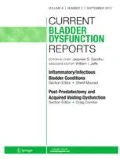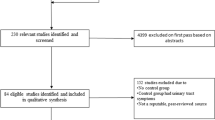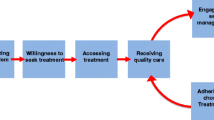Abstract
Stress urinary incontinence (SUI) is estimated to affect 12 % to 55 % of women at some point in their life. Furthermore, 15 % to 35 % of adult American women report that their quality of life is altered by urinary incontinence. In addition to the toll SUI takes on patient lives—physically, socially and psychologically—it also comes at a significant cost to health care systems. In 1999, as an initiative of the National Institute of Diabetes and Digestive and Kidney Diseases (NIDDK) and the National Institute of Child Health and Human Development (NICHD), the Urinary Incontinence Treatment Network (UITN) was born, with the primary task of developing trials to evaluate treatment of urinary incontinence in women. The purpose of this article is to review the SUI trials conducted and challenges faced, and to highlight the lessons learned from a decade of UITN work.
Similar content being viewed by others
References
Papers of particular interest, published recently, have been highlighted as: • Of importance •• Of major importance
Klutke C, Siegel S, Carlin B, et al. Urinary retention after tension-free vaginal tape procedure: incidence and treatment. Urology. 2001;58:697.
Ward RM, Hampton BS, Blume JD, et al. The impact of multichannel urodynamics upon treatment recommendations for female urinary incontinence. Int Urogynecol J Pelvic Floor Dysfunct. 2008;19:1235.
Nager CW, Brubaker L, Daneshgari F, et al. Design of the Value of Urodynamic Evaluation (ValUE) trial: a non-inferiority randomized trial of preoperative urodynamic investigations. Contemp Clin Trials. 2009;30:531.
Nager CW, FitzGerald M, Kraus SR, et al. Urodynamic measures do not predict stress continence outcomes after surgery for stress urinary incontinence in selected women. J Urol. 2008;179:1470.
Schafer W, Abrams P, Liao L, et al. Good urodynamic practices: uroflowmetry, filling cystometry, and pressure-flow studies. Neurourol Urodyn. 2002;21:261.
Albo ME, Richter HE, Brubaker L, et al. Burch colposuspension versus fascial sling to reduce urinary stress incontinence. N Engl J Med. 2007;356:2143.
• Chai TC, Albo ME, Richter HE, et al. Complications in women undergoing Burch colposuspension versus autologous rectus fascial sling for stress urinary incontinence. J Urol. 2009;181:2192. This is a secondary analysis of the SISTEr trial looking at complications of women undergoing Burch colposuspension or PVS.
Kenton K, Richter H, Litman H, et al. Risk factors associated with urge incontinence after continence surgery. J Urol. 2009;182:2805.
Richter HE, Diokno A, Kenton K, et al. Predictors of treatment failure 24 months after surgery for stress urinary incontinence. J Urol. 2008;179:1024.
Brubaker L, Chiang S, Zyczynski H, et al. The impact of stress incontinence surgery on female sexual function. Am J Obstet Gynecol, 2009;200:562, e1.
Nager CW, Albo ME, Fitzgerald MP, et al. Process for development of multicenter urodynamic studies. Urology. 2007;69:63.
Nager CW, Albo ME, Fitzgerald MP, et al. Reference urodynamic values for stress incontinent women. Neurourol Urodyn. 2007;26:333.
Lemack GE, Xu Y, Brubaker L, et al. Clinical and demographic factors associated with valsalva leak point pressure among women undergoing burch bladder neck suspension or autologous rectus fascial sling procedures. Neurourol Urodyn. 2007;26:392.
Lemack GE, Krauss S, Litman H, et al. Normal preoperative urodynamic testing does not predict voiding dysfunction after Burch colposuspension versus pubovaginal sling. J Urol. 2008;180:2076.
Albo: The Trial Of Mid-Urethral Slings (TOMUS): Design and methodology. J Applied Res. 2008;8:1.
•• Richter HE, Albo ME, Zyczynski HM, et al. Retropubic versus transobturator midurethral slings for stress incontinence. N Engl J Med. 2010;362:2066. This is the hallmark paper reporting the primary outcomes findings of the TOMUS trial.
Kraus S. Urodynamic changes 12 months after retropubic and transobturator midurethral slings. In: AUA Annual Meeting Washington, D.C., 2011.
• Brubaker L, Norton PA, Albo ME, et al. Adverse events over two years after retropubic or transobturator midurethral sling surgery: findings from the Trial of Midurethral Slings (TOMUS) study. Am J Obstet Gynecol. 2011;205:498 e1. This is an important article by the UITN reporting adverse events 2 years following TMUS or RMUS.
Nager CW, Kraus SR, Kenton K, et al. Urodynamics, the supine empty bladder stress test, and incontinence severity. Neurourol Urodyn. 2010;29:1306.
• Nager CW, Sirls L, Litman HJ, et al. Baseline urodynamic predictors of treatment failure 1 year after mid urethral sling surgery. J Urol. 2011;186:597. This secondary analysis by the UITN examined baseline UDS to determine predictors of mid-urethral sling failure.
Kuhn A, Nager CW, Hawkins E, et al. A comparative study of water perfusion catheters and microtip transducer catheters for urethral pressure measurements. Int Urogynecol J Pelvic Floor Dysfunct. 2007;18:931.
Martan A, Masata J, Petri E, et al. Weak VLPP and MUCP correlation and their relationship with objective and subjective measures of severity of urinary incontinence. Int Urogynecol J Pelvic Floor Dysfunct. 2007;18:267.
Acknowledgment
This work was funded in part by grant support from the National Institutes of Health.
Disclosure
Dr. Lemack has served as a consultant for Astellas; received payment for development of educational presentations (including service on speakers’ bureaus) from Allergan, Astellas, and Pfizer; held stock/stock options in Pfizer; and had travel/accommodations expenses covered/reimbursed by Allergan, Astellas, and Pfizer.
Drs. Dillon and Lee reported no potential conflicts of interest relevant to this article.
Author information
Authors and Affiliations
Corresponding author
Rights and permissions
About this article
Cite this article
Dillon, B.E., Lee, D. & Lemack, G.E. Lessons Learned from a Decade of Multicenter Cooperative Clinical Trials in Stress Urinary Incontinence. Curr Bladder Dysfunct Rep 7, 163–168 (2012). https://doi.org/10.1007/s11884-012-0141-z
Published:
Issue Date:
DOI: https://doi.org/10.1007/s11884-012-0141-z




